Triathlon is the answer for those who don't consider one sport enough. Consisting of a swim, bike and run raced over a variety of distances, triathlons provide a substantial challenge of endurance, strength and mental toughness. The bike component of a triathlon makes up a considerable part of every event, approximately 60% of the race regardless of the chosen distance. As a result, triathlon specific bikes with different cockpit set-ups, different geometry, advanced aerodynamics and innovative storage solutions are highly sought-after.
We've put together this buyer's guide to help explain what a triathlon bike is, how it differs from road and time trial bikes, the key features to look out for, and most importantly, how to choose the right one for you.
Triathlon formats explained
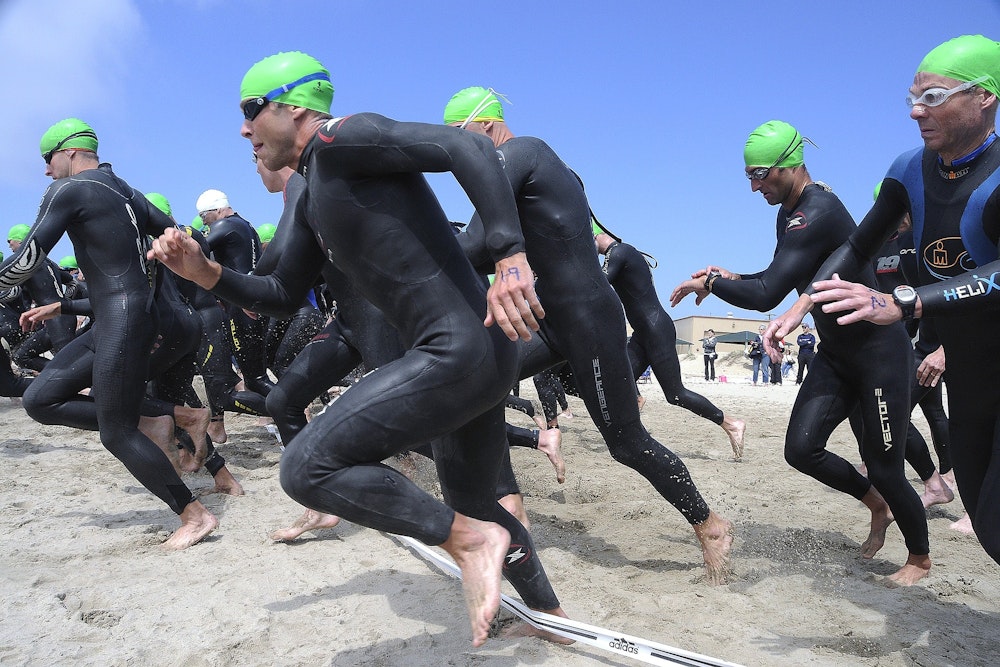
Before we jump into the specifics of a triathlon bike, it's important to know the different type of event formats and distances as they will influence your decision making. Depending on the format and distance of the event, it could take anywhere from under an hour to over 15 hours to complete, which includes anywhere from half an hour on the bike, to well over six hours in the saddle.
The two formats are 'drafting' and 'non-drafting'. Most age group and long course events are non-drafting, meaning you cannot gain an advantage by sitting close to a rider in front of you. Non-drafting events will stipulate a minimum distance you have to maintain behind the person in front of you when on the bike. Ironman's draft zone for age-group competitors is as follows; 'The Age-Group bicycle draft zone is 10 meters long, measured from the leading edge of the front wheel and extending towards the back of the bike (five bike lengths of clear space between bikes). An age-group athlete may enter the draft zone of another athlete when passing and must continuously progress through the draft zone. A maximum of 20 seconds will be allowed to pass through the zone of another athlete.'
As a result, most people choose triathlon specific bikes for these events over road bikes to optimise aerodynamics, integration, comfort, and storage. The longer the event is, the more important storage and comfort become.
Conversely, draft legal events, like ITU (International Triathlon Union - the sports governing body) races, World Championships, and the Olympics Games, allow athletes to gain an advantage on the bike by drafting. In these events, time trials bikes are not allowed, and the road bikes used must adhere to similar conditions as the UCI road bike regulations, which we'll go into detail shortly.
Below are the various distances of the four most common triathlons. All of them can be non-drafting events raced on triathlon bikes, but only 'sprint' and 'Olympic' are commonly drafting events raced on road bikes.
| Event | Swim | Bike | Run |
|---|---|---|---|
| Sprint | 750m | 20km | 5km |
| Olympic | 1500m | 40km | 10km |
| Half Ironman / 70.3 | 1900m | 90km | 21.1km |
| Ironman | 3800m | 180km | 42.2km |
Triathlon bikes vs Time Trial bikes vs Road bikes
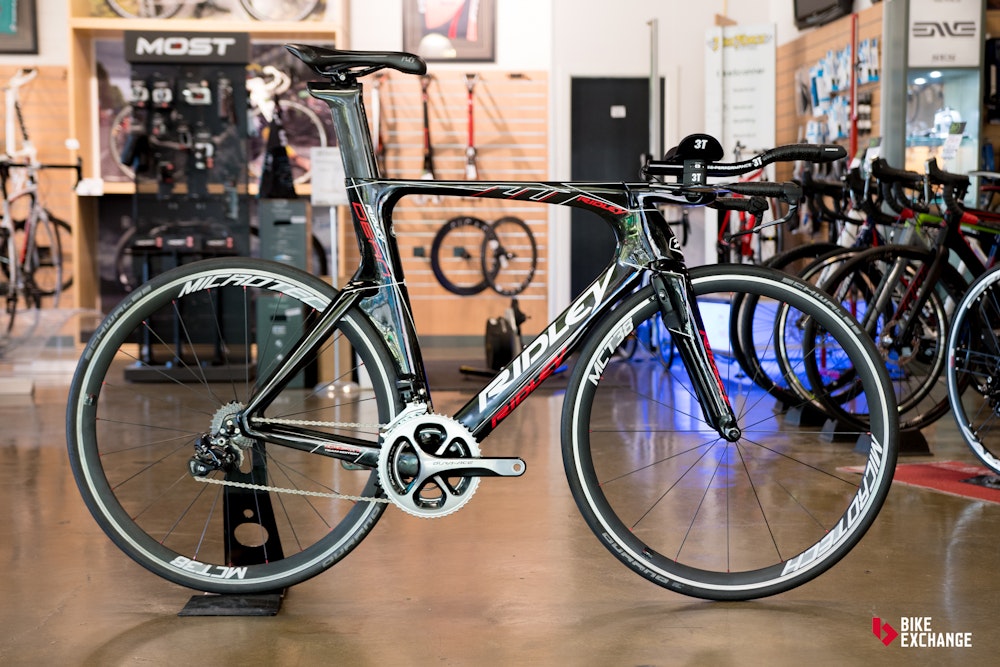
Time trial bikes are bound by UCI regulations (cycling's governing body) with an extensive list of controls and standards that manufacturers have to meet before a bike is given approval to race. A brief outline of some of these standards is below.
Time trial frames: UCI legal bike frames needs to take on a triangular shape, with no greater than a 3:1 tube profile ratio, which means a tube can't be more than three times deeper than it is wide. The bike can be no lighter than 6.8kg and there are many specifications regarding rider position outlined below.
Saddle position: Saddles must measure between 24-30cm with the tip of the saddle 5cm behind the vertical line of the bottom bracket spindle, and at no greater angle than +/- 9 degrees.
TT extensions: The TimeTrial handlebar extensions cannot extend further than 75cm from the vertical line of the bottom bracket spindle, including accessories which could be an extended shifter for example. There are some exceptions for 'morphological' reasons (due to the size and limbs of the rider) whereby a rider who is excessively short or tall, is allowed extra distance but only after seeking approval from the UCI. For example, riders 190cm or taller can move their TT extensions a further 10cm forward, out to a maximum of 85cm from the vertical line of the bottom bracket spindle.
Aerodynamic restrictions: No additional fairings or pieces with the aim of improving aerodynamics are allowed, and no modifications can be made to the frame. Water bottles are only allowable on the down tubes and cannot be integrated into the frame for aerodynamic gains. There are even restrictions on the size of the water bottles riders can use in a UCI sanctioned time trial.
As triathlon events are not bound by these standards, manufacturers have no limits placed upon them in the creative process. As such, we often see triathlon bikes without seat tubes; saddles and TT bar extensions positioned well forward; tube profiles in excess of the 3:1 ratio; fairings located in various positions on the frame to improve aerodynamics; and plenty of modifications to the frame including hydration, nutrition and accessory storage.
An alternative to both of those options is a standard road bike, which is commonly used with clip-on extensions, simulating the forward aero position of time trial and triathlon bikes. Adding extensions is obviously a cheaper alternative to buying a new triathlon bike (assuming you already have a road bike), but you do miss out on the triathlon specific geometry, aerodynamics, integration, and storage. Read our Ultimate Guide to Buying a Road Bike for more information on road bikes.
Geometry
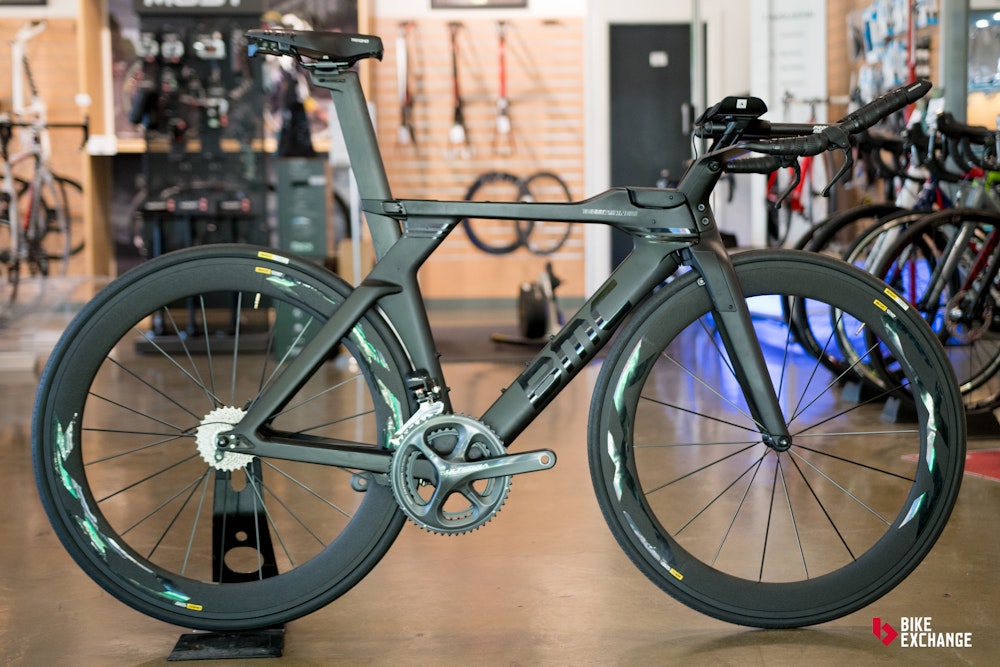
The purpose of any bike is heavily influenced by its geometry and triathlon bikes are no exception. Triathletes need to be comfortable for long periods of time in an aerodynamic position and be able to run long distances once off the bike. As such, the seat tube angle and top tube length are the two key differences between triathlon bikes and road bikes that are aimed at recruiting different muscle groups and providing comfort without sacrificing performance.
Here's an excerpt from our How to Use Bike Geometry Charts and What They Mean article in relation to the seat tube angle of road bikes.
The seat tube angle refers to the angle of the seat tube in relation to the ground. An easy way to think of this is to measure the seat tube angle against an imaginary straight line between the front and rear dropouts. The seat tube angle doesn't change much, generally sitting between 71-74 degrees. Changing the saddle set back position can virtually influence the seat tube angle, effectively making is slacker or steeper.
Triathlon bikes have a much steeper seat tube angle than road bikes, typically starting at 74 degrees and extending to over 80 degrees, Cervelo's latest triathlon specific bike, the P5X, has an effective seat tube angle of 81 degrees for example. This large push forward recruits more gluts and hamstrings through the pedal stroke, saving the quadriceps for the run leg of the race. It also allows riders to adopt an aggressive aerodynamic position and reduce their frontal profile (the surface area that meets the wind).
This ultra aggressive positioning is great for aerodynamics but can be hard to maintain for long periods of time, especially for those lacking the flexibility and mobility through their hips and lower back. To combat this, it's common for the crank length of triathlon bikes to be slightly shorter than road bikes and for them to adopt specific saddles that better cater for the pronounced anterior pelvic tilt that comes from bending forward. These small changes open up the angle of the hips, increasing comfort that enables riders to stay in that position for long periods.
A longer top tube and elongated reach is another feature of triathlon bikes. This change aims to stretch out the rider, putting them in a more aggressive, horizontal position that improves their aerodynamics. Doing this also helps to ensure a rider's weight is evenly distributed between both wheels.
Aerodynamics
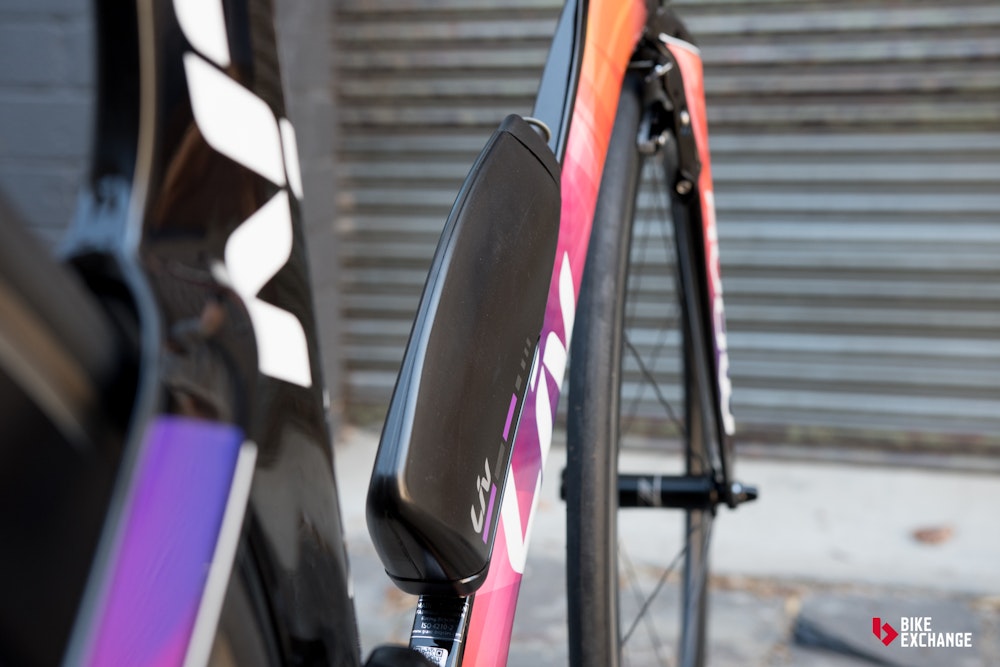
Aerodynamics are a key component of triathlon bikes as any small advantage that can be gained adds up over hours on end in the saddle. And because most triathlon courses are flat with very few hills, weight isn't much of a concern. As we've mentioned, triathlon bikes are not bound by the same restrictions as time trial bikes, allowing for their creations to be far more innovative.
The flip side of that is triathlon bikes need to incorporate significant amounts of storage, thereby adding more pieces to the aerodynamic puzzle. Triathlon bikes utilise the same Computational Fluid Dynamics and dynamic wind-tunnel testing that road racing bikes do, but in most cases, they will conduct the testing with the bike race ready and complete with storage for fluid, tools, and food. Some manufacturers even use these modifications and additions to enhance the bike's aerodynamics.
One way to enhance aerodynamics is by using oversized tube profiles, something brands such as Specialized, Felt and Diamondback are chief protagonists of. The oversized profiles help the wind pass along the bike without deviation, which would otherwise cause turbulent air flow and increase drag. This is most commonly seen on the front forks, downtube, and seattube. Other manufacturers will mimic this oversized tube profile by effectively cutting the 'tail' off an oversized tube profile, which, reduces overall weight, creates a stiffer structure and simulates the same airflow, Trek and Scott are good examples of this practice.
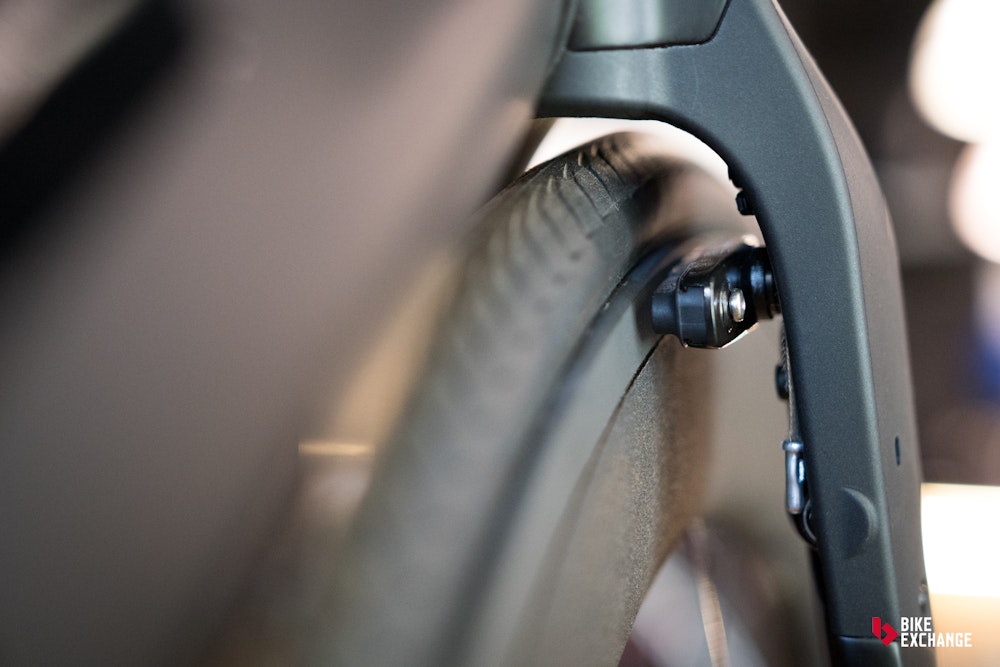
Another way manufacturers improve a bike's aerodynamic efficiency is to 'hide' or integrate things like brakes, cables, and storage. Brakes for triathlon bikes are commonly found behind the forks, inside the forks or hidden behind fairings at the front of the bike. At the rear of the bike they are located underneath the bottom bracket area, or out of the wind in partial tube cutouts on the seatstays. Internal cables are common on the majority of bikes these days, aiding aerodynamics and reducing the chance of them getting damaged by environmental factors.
Altering the frame shape is another common method of enhancing aerodynamics. Cervelo has featured a dropped downtube for a long period of time, which, reduces the space between the downtube and front wheel, improving airflow. Dropped seatstays are another common modification, which, limits the frontal area contacting the wind and reduces drag as a result, the Felt IA's seatstays a standout example. Some brands have even removed the seatstays altogether, Cervelo, Diamondback, Softride and Falco all offer examples of triathlon bikes with no seat tube and seatstays as a result.
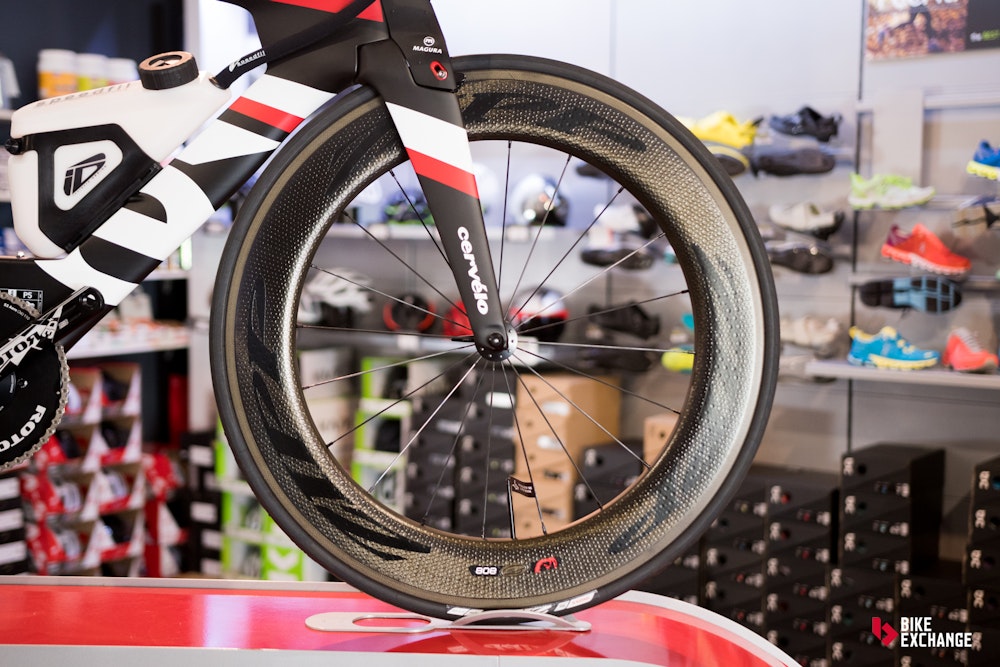
And finally, wheels are another way aerodynamics are enhanced for triathlon bikes. Generally, the deeper the wheel profile the more aerodynamic, although it does make the bike harder to handle given they will be more affected by side wind than a shallow rim, and the extra material required also creates a harsher ride by not offering as much compliance (comfort) as a shallower wheel. To learn more about wheels and how they influence aerodynamics, comfort and ride quality read our feature article, Road Bike Wheels: What to Know
While some of these solutions might be cost prohibitive, it's worth noting that a good aero helmet, skinsuit, and position on the bike can be just as valuable in terms of time savings. This article highlights the biggest bang for your buck when it comes to aerodynamics, and you might be surprised how much of a difference the little things can make.
Integration and Storage
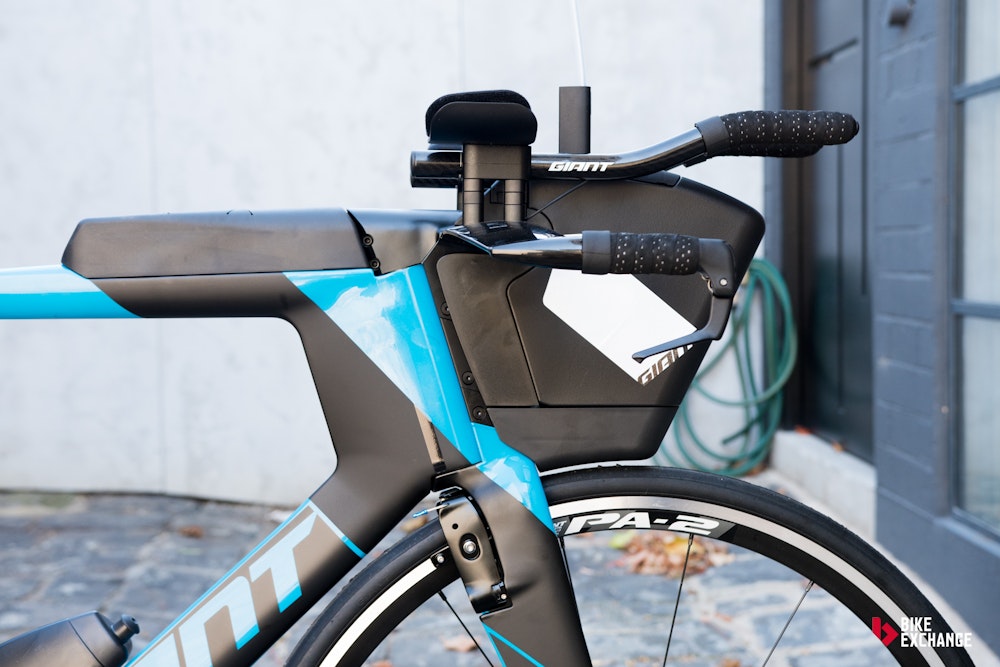
We've spoken about the integration of brakes and cables to enhance aerodynamics, but the integration of storage systems for tools, fluid, and nutrition is just as important from a functional point of view.
Once upon a time, triathlon bikes had many after-market modifications like rear water bottle holders behind the seat, saddle bags, chunky storage cases on the top tube for food, and who could forget the old sticky taping gel packets to the top tube? Modern triathlon bikes are much more sophisticated with storage solutions, integrating them into the bike design, eliminating the need for retrofitted parts.
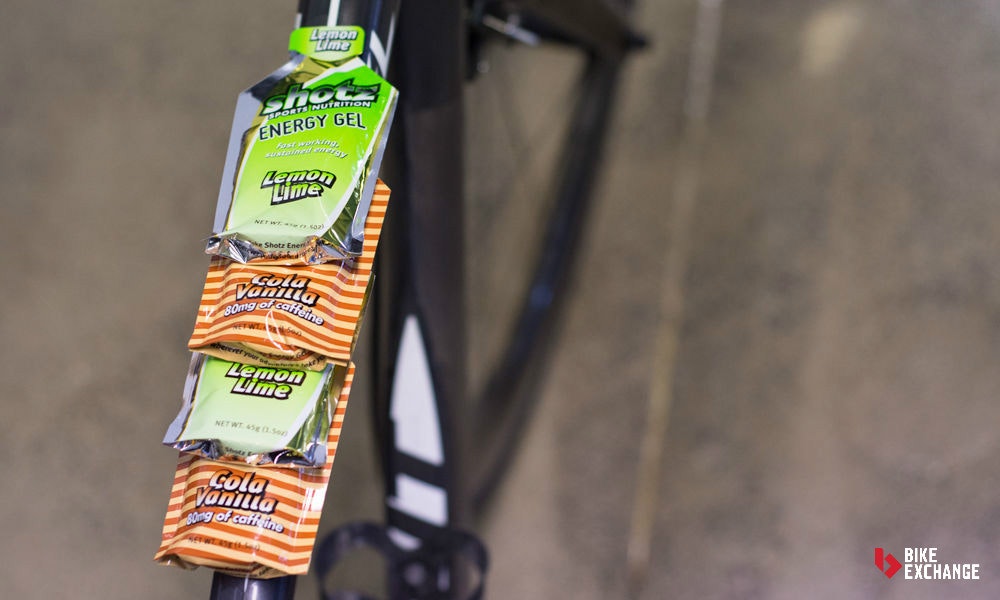
Giant has its 'AeroVault System', a front hydration storage system that was engineered with the frame to carry the same amount of water as a traditional sports bottle as well as improving the bike's aerodynamics. Cervelo's P5X and the Diamondback Andean each have an integrated storage system for tools that fills the space between the front and rear wheel. Trek has its 'draft box' which sits behind the seattube and millimetres above the rear wheel to assist airflow as well as providing a great storage solution for spares, tubes, and tools. Specialized has an integrated hydration system it refers to as the 'Fuelselage Hydration System' inside the super thick downtube, eliminating the need for water bottles on the downtube. And virtually all brands offer integrated top tube storage for food.
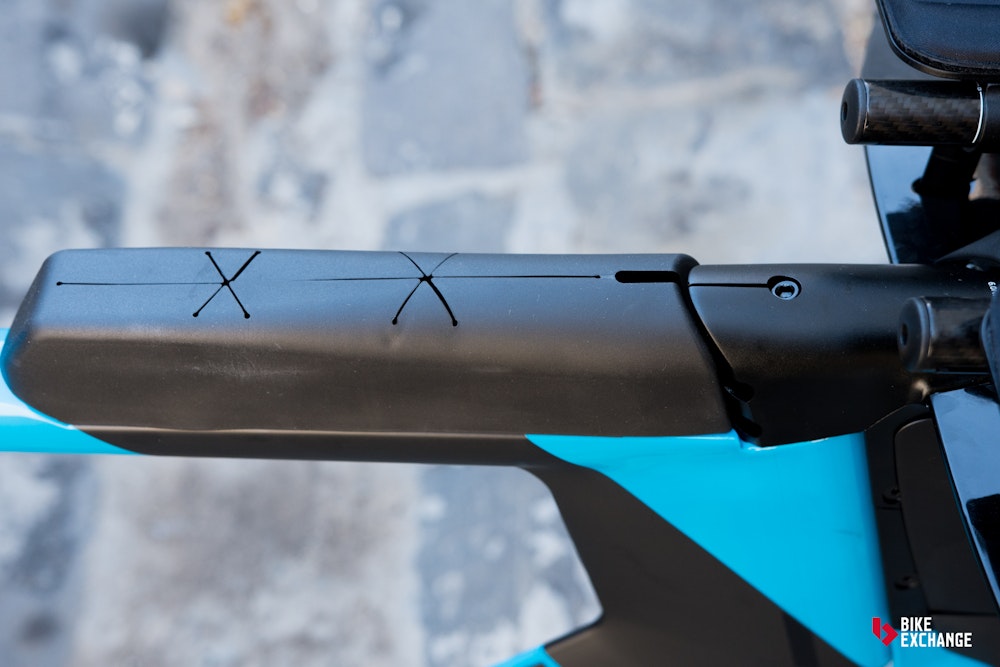
Of course, all of these features come at a cost and generally, the more expensive a bike is, the more integration it has. This is most obvious at the front of the bike. Entry level models tend to have basic cockpit set-ups featuring traditional fork, steerer tube, stem, and handlebar combination, without any integrated storage systems. This can be beneficial from a functional point of view because it allows for easy adjustment and maintenance when required. Conversely, top-tier models have highly integrated cockpit set-ups with multiple fairings, modifications, and integrated storage systems. This approach enhances aerodynamics and integration but can make adjustment and maintenance more difficult.
Comfort
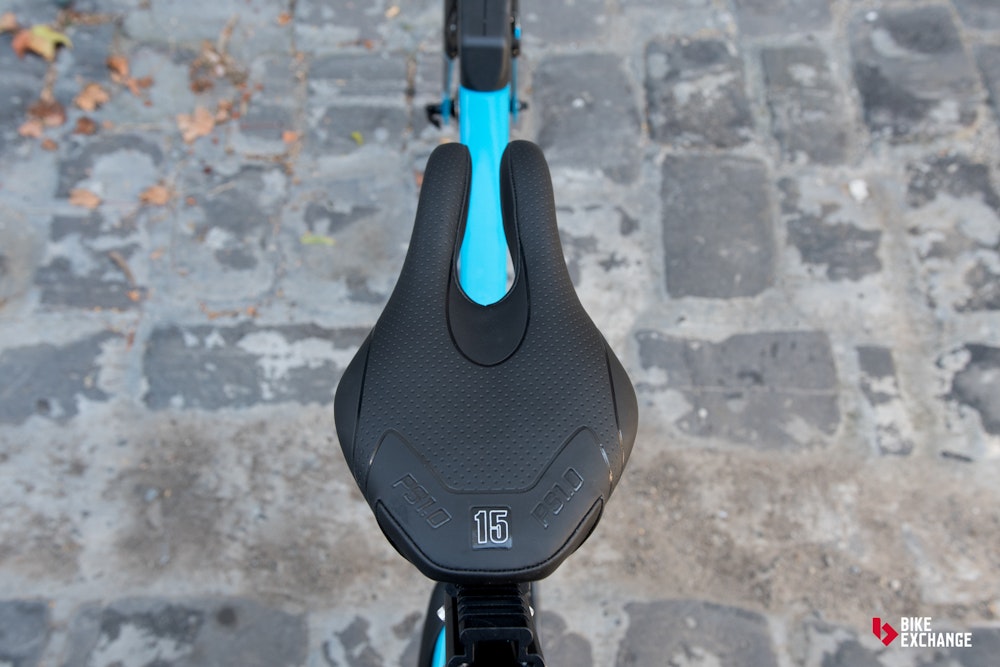
Comfort is important when riding any bike but even more so for triathlon. Long distance events are upwards of 90km of solo riding, which could take anywhere from two hours (if you're a pro) to over six hours for an Ironman. Add to that a run off the bike for a minimum distance of 20km and the importance of comfort, and as a result saving energy, is obvious.
The triathlon-specific geometry helps with that but there are some important comfort considerations when making your purchase.
- Adjustability: We all have different body shapes, composition, flexibility, and mobility so being able to adequately adjust your bike is important. Choosing the right size bike is the crucial first step, and from there, being able to easily adjust your position will help your performance to no end. Look for bikes with multiple levels of cockpit adjustment, not just forward and back. Good triathlon bikes will allow for the front pads to be moved forward, back, closer together or further apart and up or down via the use of spacers.
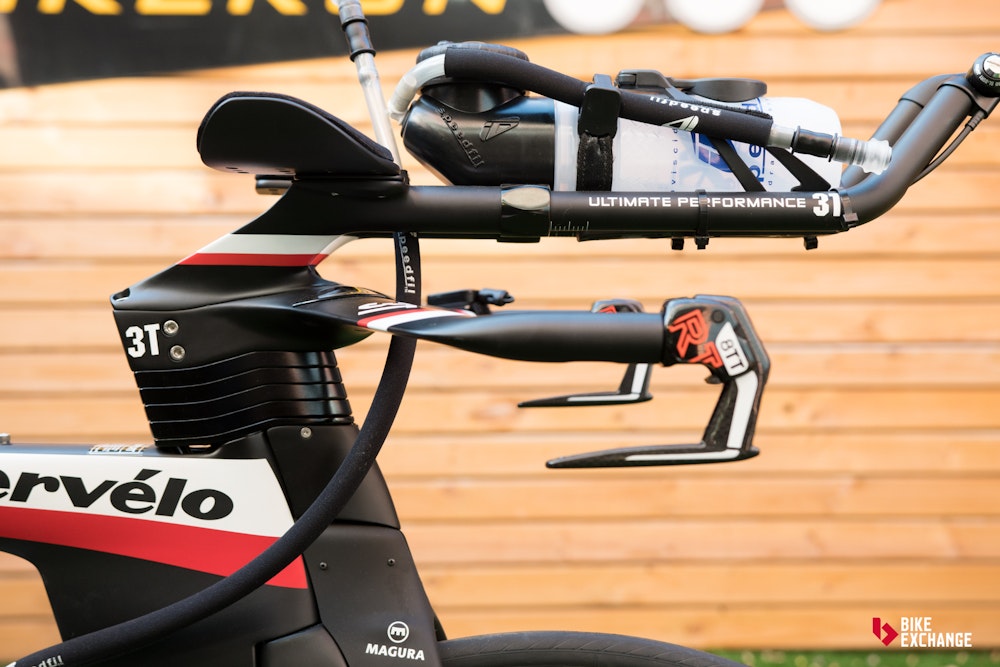
- Saddle: Triathlon specific saddles were created to allow for a more aggressive, bent over position on the bike with prominent anterior pelvic tilt. They are often shorter than traditional saddles with a cutout section in the middle which takes the pressure off the soft tissue of the pelvis that would otherwise be compressed with a normal saddle.
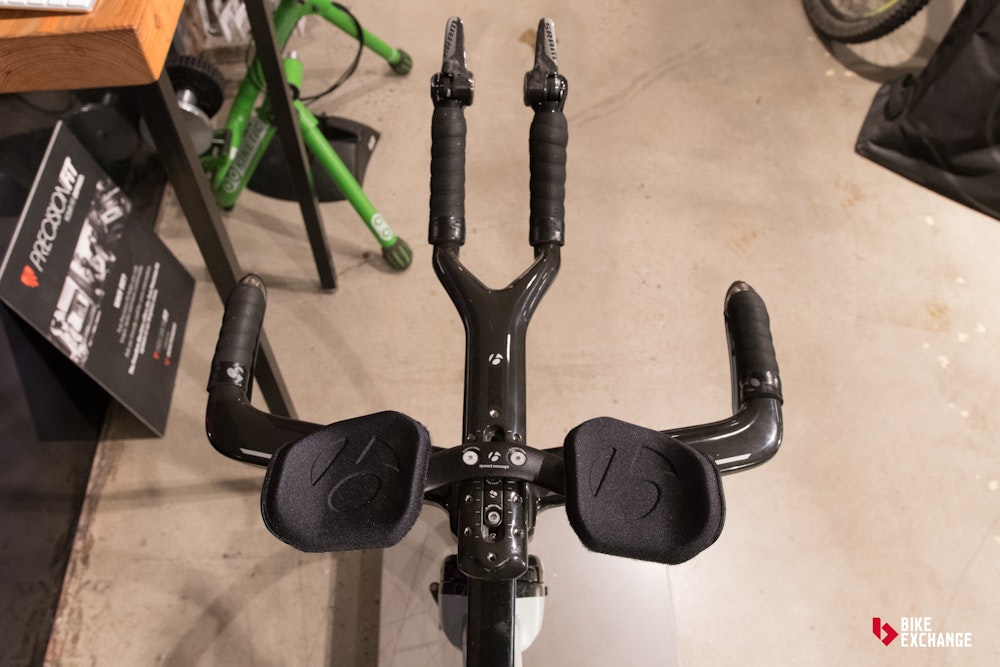
- Shape of extensions: The shape of the TT extensions can also go a long way to improving comfort. Extensions can be straight, curved, or point upwards depending on your preference. The aim is to keep your wrist in a neutral position and achieve right angles at your elbow and shoulders. This position provides good levels of structural support for your upper body and won't impinge any nerves or restrict blood flow.
Gearing
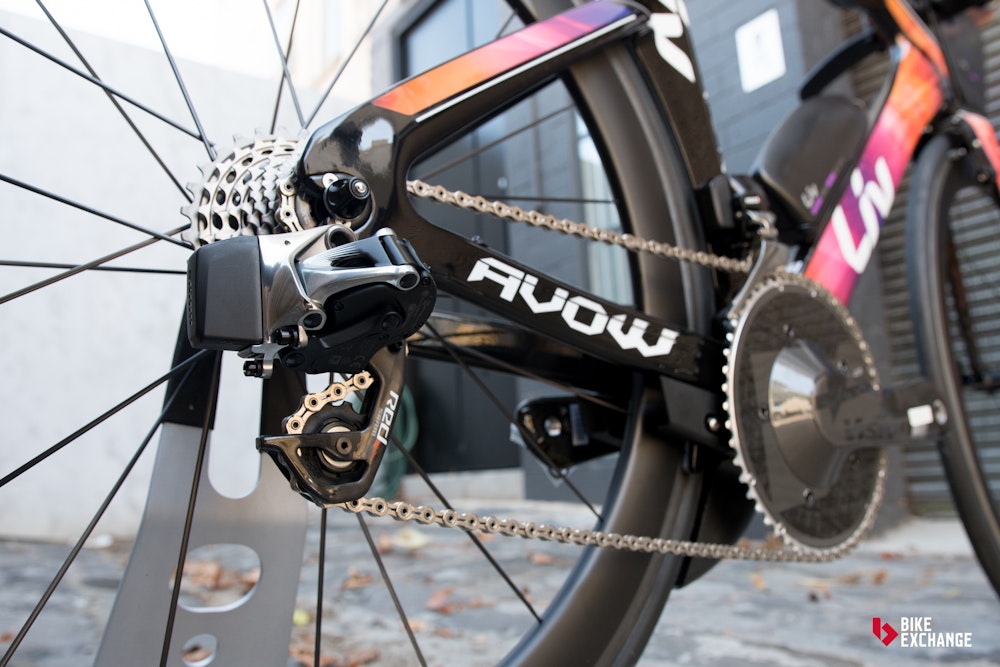
Normally when we discuss gearing for a particular type of bike we discuss ratios and ranges but when it comes to triathlon bikes, the choice between electronic and mechanical is the focus.
Arguably the best place for electronic shifting is on a time trial or triathlon bike. Not only does electronic shifting remove the laborious cable routing process due to internal cabling, long tube lengths, and sharp bends of TT and triathlon bikes, it also eliminates the need to move your hands to the bar ends to shift if you are on the brake-bars.
Shimano, Campagnolo, and SRAM all have electronic options that allow you to change gears from both the TT extensions and the brake-bars, Shimano going one step further with their new 'Synchro shift' technology, providing an almost automatic response in front shifting based on the position of the chain on the rear cassette.
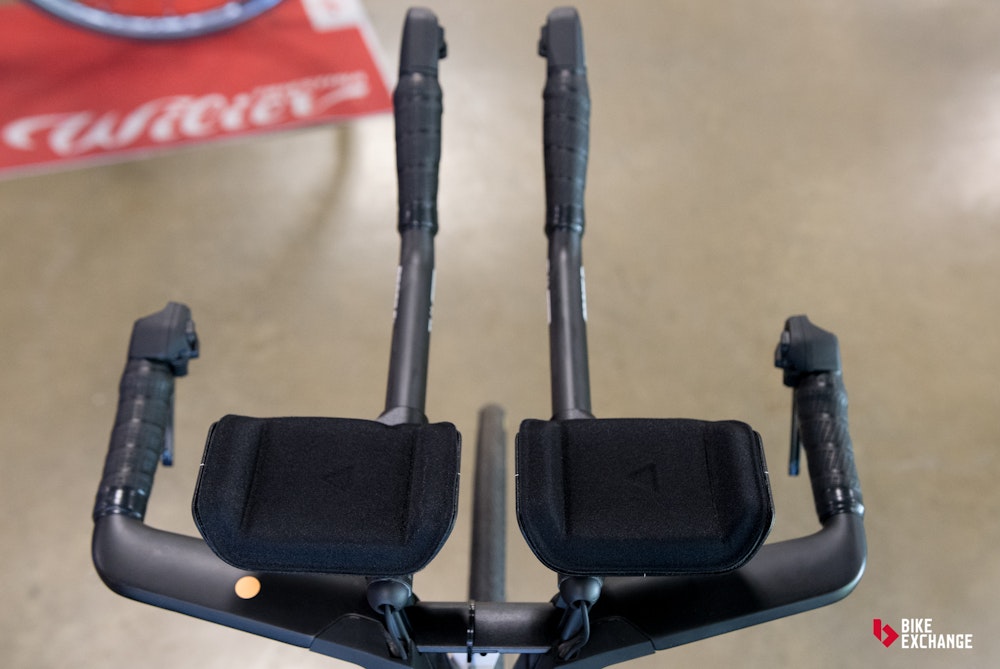
If you do decide to go for electronic, be sure to charge it as required, we've heard too many stories of flat batteries on event day.
As for gear ratios, triathlon bikes typically share the same size gearing and range as that of road racing bikes. Typically the longer the races, the more you'll want a wider range.
Budget
Just like most other bikes, spending more money on a triathlon bike will typically (but not always) result in a reduction of weight, improved shift quality, increased durability and greater comfort. For triathlon bikes specifically, you can also expect greater integration and aerodynamics too.
Below is a breakdown of what to expect depending on your budget.
Under AUD$2,000
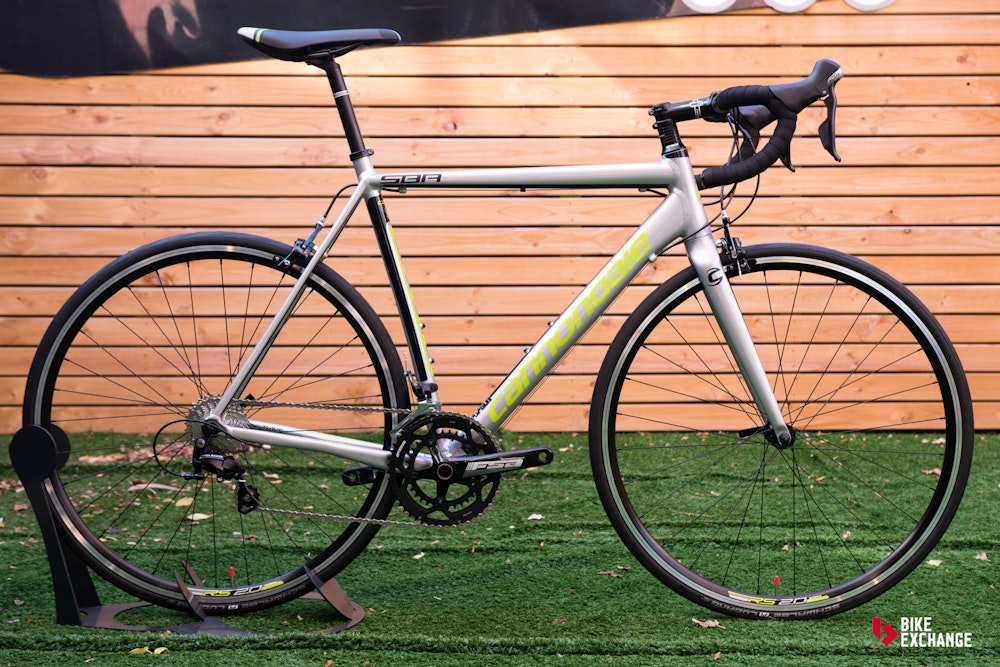
The best option in this price range is to go for a road bike and add clip-on TT extensions. Due to the extensive research and integration that goes into a triathlon bike, they are comparatively more expensive than a road bike, so the next price bracket is the go-to range of a triathlon-specific bike.
Between AUD$2,000 and AUD$4,000
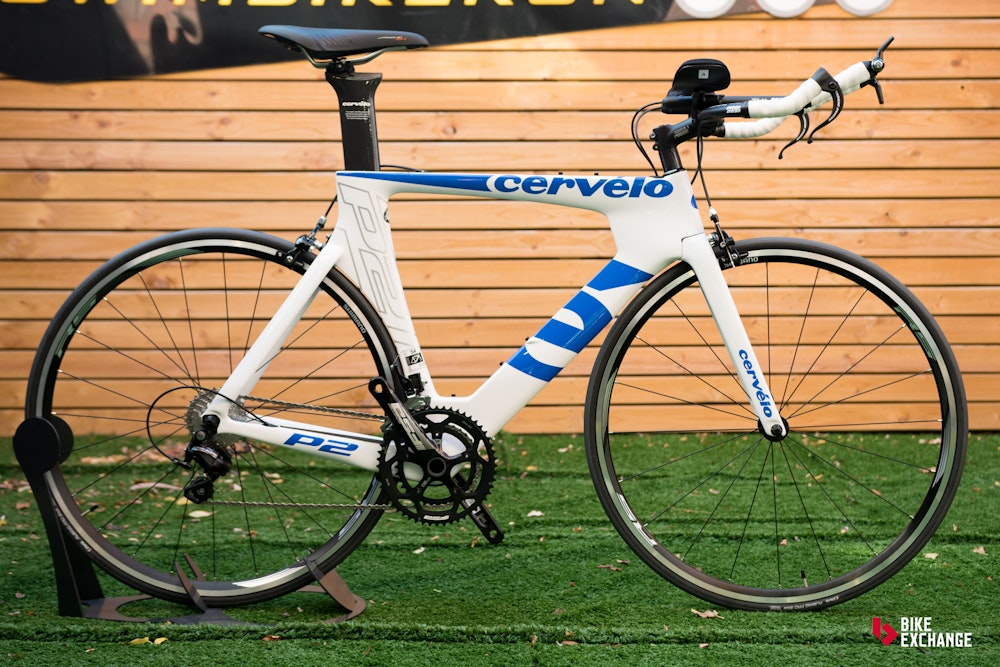
This is the sweet spot for the best triathlon bike for beginners with the frame design featuring similar aerodynamic properties as more expensive models, and the standard cockpit set-up of a steerer tube, stem and handlebar construction making it easier for riders to adjust their position and make frequent small changes. The frame will typically be made from carbon with internal cabling, hidden rear brakes (potentially front too), and basic levels of integrated storage.
Shimano 11-speed 105 componentry should be expected as a minimum, although don't expect to find any electronic gearing options within this price range. Wheelsets are a key point of consideration for a triathlon bike, with many of the bikes at this price point coming equipped with a more basic training wheelset. The general expectation is to buy a higher-end race wheelset to get the most out of the bike on race day.
For more on what to expect within this price range and a list of some greats options for 2017, check out our Best Triathlon Bikes for AU$4,000 article.
Over AUD$4,000
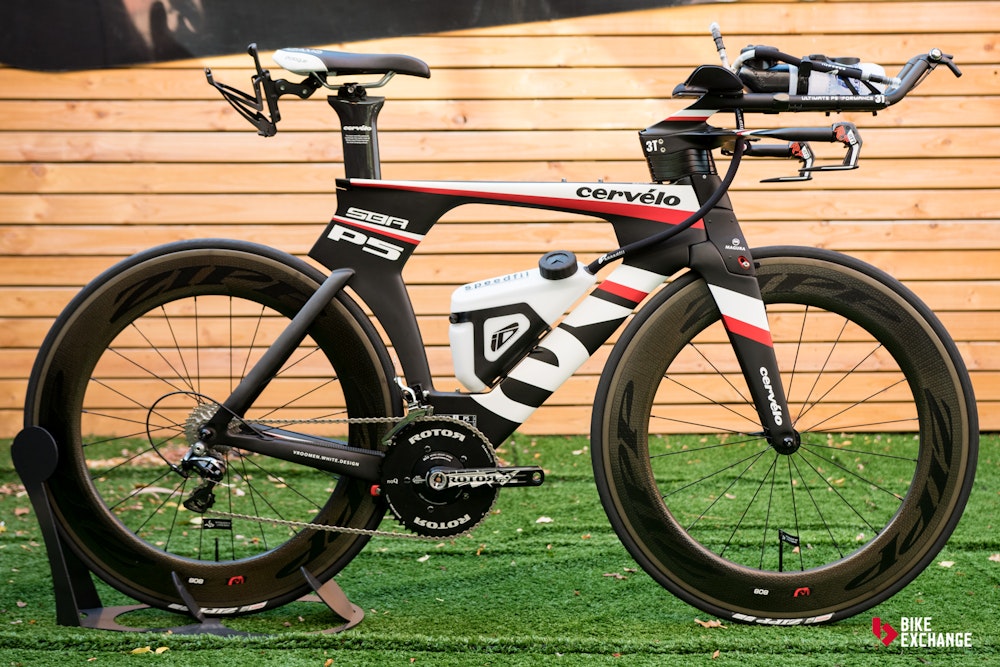
As you spend more money, greater integration for hydration, food, and tool storage feature, as does more cockpit integration. Shifting moves from mechanical to electronic, enabling you to shift from the bar extensions as well as the handlebars. Upgraded deep profile wheelsets that reduce drag and improve aerodynamics are also common, although, manufacturers will often equip their bikes with a basic set of training wheels to reduce costs, as many triathletes will save deeper profile wheels or a disc wheel for race days.
Do some research
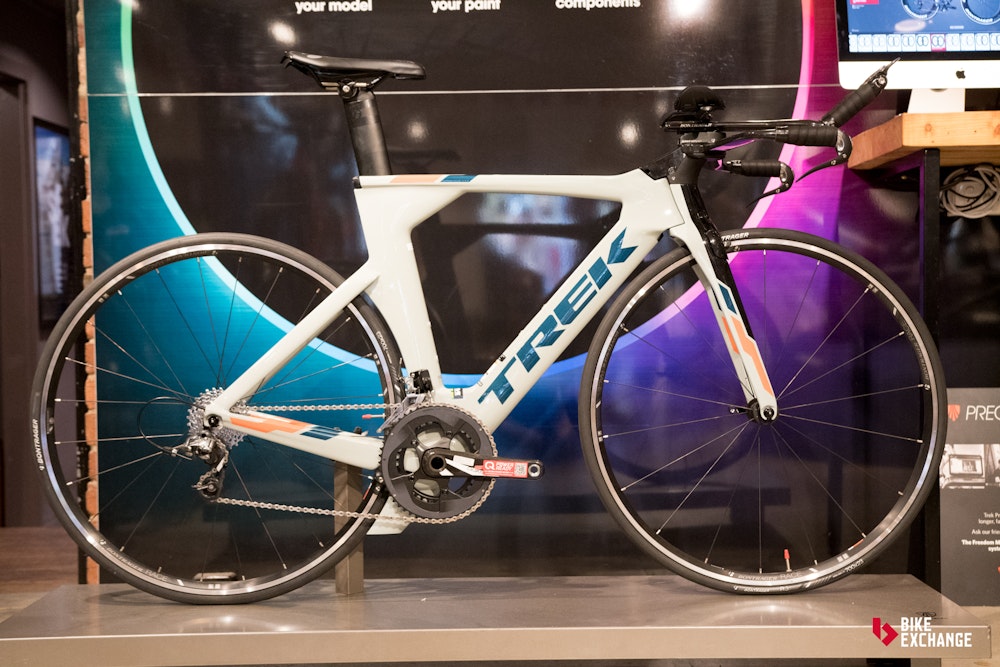
To help you make an informed decision, create a list of your top five bikes and do some research.
As well as trawling through cat videos, YouTube can also be used as a quick source of easily consumable information. Look for videos from the manufacturers for specifications and technology information but also look for impartial people or companies providing their opinions.
Look for reviews from other sources too. Magazines, websites, blogs all provide valuable information, normally in much more detail than an online video. And while you're online, look at forums or reviews for information, and be sure to check the comments section at the bottom. At this point in time our Blog team haven't recently reviewed any triathlon bikes, but we're working on fixing that.
Test ride
The best way to know if a bike is for you is to ask lots of questions and take it for a test ride. Only by taking a bike for a ride will you get a feel for its characteristics, size, geometry and intricacies.
When taking a bike for a test ride, don't just go around the block and make a decision. If possible try to get it for the weekend, or at least try to simulate the type of riding you plan to do. The best place to test ride a triathlon bike is at an event expo. The event sponsor will typically have a whole fleet of their triathlon models on site for you to try. Some shops may have their own demo bikes to test but it's not guaranteed and because triathlon bikes are so specific, it's unlikely (unless they are a triathlon-specific store), that they will have demo models available, so best to call up and ask ahead of time.
Get a bargain
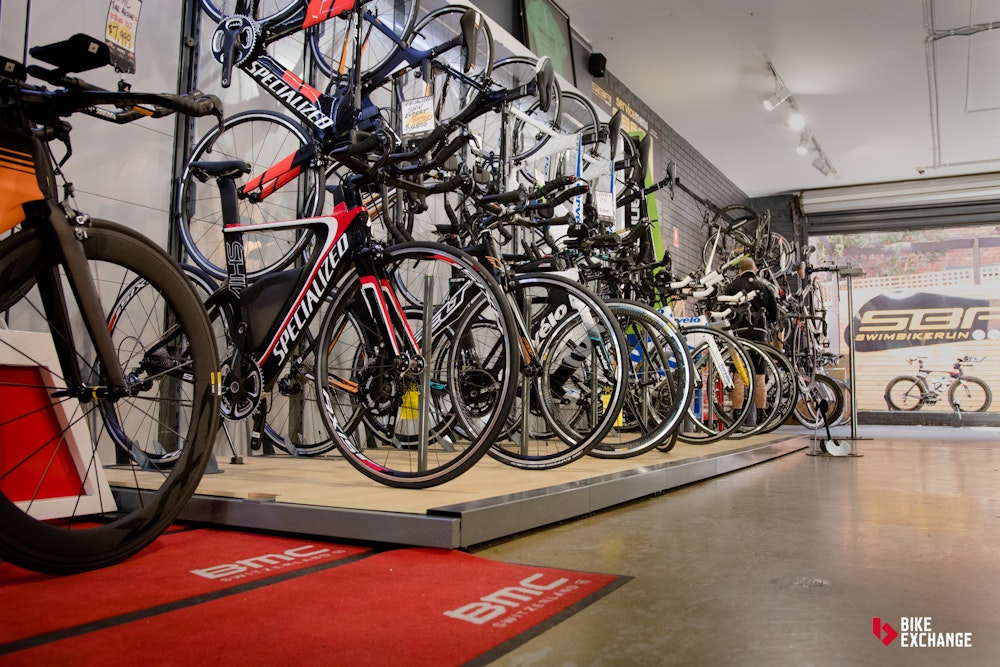
Here are some tips to help you grab a bargain
EOFY: End of financial year is a great time to buy a bike. Retailers are looking to clear old stock to make way for new, creating the perfect opportunity to get a great price on the current or last years model. Triathlon bikes typically work on a three to four-year life cycle, meaning the bike is wholly updated every three to four years. If you time it right, you can get yourself a great deal at the transfer of product seasons.
End of season: Triathlon season, whether it be long course or short course, is typically run during the warmer months of the year, and so many people finish the season and look to upgrade their bike with an eye on next season or move to other pursuits. As a result, this is a great time to pick up a good deal on a race ready bike.
Christmas: Christmas is another good time of year to get a bargain. Christmas is the busiest time of year for retailers and the bike industry is no exception. Many retailers will try to clear old stock that didn't sell during the end of financial year period or add sweeteners such as a pair of shoes or a computer in the spirit of Saint Nic.
Demo's or floor stock: Most bikes shops will order stock in bulk to keep costs down and have display models that people can view and test ride. Once these bikes have served their purpose they are sold at a greatly reduced price to account for the usage. These bikes are normally well maintained and aside from having a few kilometres on the odometer, they are virtually brand new.
Buying online: Buying online from a manufacturer cuts out the middle-man, reducing the overall cost which is then passed on to the consumer. This can be a great way to save money but should be approached with caution. Buying online has its pitfalls; you generally can't inspect the bike, take it for a test ride, check if it fits, assess unique features, make alterations or ask questions. It's a risky game unless you know your exact size and specifications.
Local Bike Shop: More often than not, bike shops will come to the table with a deal or price that makes both parties happy. Shopping locally allows you to talk to someone, check out the bike and take it for a ride. You may pay a small premium but you will most likely end up saving money compared to an online purchase as most shops will include a bike fit and ongoing servicing with a sale. Good bike shops know the bike and the brand and will work hard to make you happy and keep you as a customer.
We hope this buyers guide has been helpful and provided some valuable information. You can browse BikeExchange for triathlon bikes, or search for your local bike shop to get further assistance.
**Follow BikeExchange: [Email](http://www.bikeexchange.co.nz/subscribe) | [Facebook](https://www.facebook.com/BikeExchange.com.au) | [Twitter](https://twitter.com/bikeExchange) | [Instagram](https://www.instagram.com/bikeexchange/) | [YouTube](https://www.youtube.com/user/BikeExchangeTV) | [STRAVA](https://www.strava.com/clubs/BikeExchange)**





